As a gardener or someone interested in preserving fruits and root vegetables, you may have wondered about the best ways to store your produce for long-term use. Two popular options for storage are fruit cellars and root cellars. Understanding the differences and knowing the optimal storage tips can help ensure the freshness and quality of your harvest throughout the year.
When it comes to cellar storage, both fruit cellars and root cellars provide excellent options for preserving produce. Fruit cellars are specifically designed for storing fruits, while root cellars are ideal for root vegetables and other produce that require cool and dark environments. Fruit cellars are typically above ground and provide a controlled cold storage space for fruits, while root cellars are usually underground and offer natural cooling and humidity.
Key Takeaways:
- Optimal storage of fruits and root vegetables can be achieved through fruit cellars and root cellars.
- Fruit cellars are designed for storing fruits, while root cellars are suitable for root vegetables and other produce.
- Fruit cellars are typically above ground, while root cellars are underground.
- Fruit cellars provide controlled cold storage, while root cellars rely on natural cooling and humidity.
- Understanding the differences and following optimal storage tips can help maintain the freshness and quality of your produce.
What Is a Root Cellar?
A root cellar is a storage location that utilizes the natural cooling, insulating, and humidifying properties of the earth. It is a time-tested storage method for storing homegrown produce or locally sourced fruits and vegetables. Root cellars are ideal for storing root vegetables, canned or pickled vegetables, and even homemade alcoholic beverages.
Root cellars provide a reliable and sustainable solution for preserving crops long after harvest. By harnessing the earth’s natural properties, they create a controlled environment that helps maintain the freshness, flavor, and nutritional value of stored produce.
Root cellars are traditionally built underground or partially submerged in the earth, allowing them to benefit from the earth’s insulating effects. The surrounding soil acts as a natural barrier against extreme temperature fluctuations, providing a stable and cool storage environment throughout the year.
“A root cellar is like having your own personal pantry that stays cool and moist without the need for electricity or artificial cooling methods.”
Root cellars not only offer a practical storage method but also promote sustainability and reduce reliance on refrigeration, contributing to energy conservation and lower carbon footprints.
Root cellars can be used to store a wide variety of produce, including:
| Fruits | Vegetables | Others |
|---|---|---|
| Apples | Carrots | Canned or pickled vegetables |
| Pears | Turnips | Homemade alcoholic beverages |
| – | Parsnips | – |
| – | Beets | – |
| – | Rutabagas | – |
| – | Winter radishes | – |
With proper planning and implementation, a root cellar can be a valuable addition to any homestead or garden. Let’s explore the advantages of root cellars and how to create and maintain an efficient storage system for your harvested bounty.
Advantages of Root Cellars
Root cellars offer numerous advantages that make them an essential part of any sustainable home. Not only do they enable you to store high-quality homegrown vegetables, but they also provide food security and help reduce your electric bill.
“Root cellars are a game-changer when it comes to preserving the freshness and flavor of your harvest. I love being able to enjoy the taste of homegrown vegetables all year round.”
One of the biggest advantages of using root cellars is the superior quality of the vegetables you can store. Unlike grocery store produce, which may have been harvested before it fully ripens and travels long distances, homegrown vegetables can be picked at their peak and stored immediately.
By storing your vegetables in a root cellar, you ensure that you have access to high-quality, fresh vegetables even during the off-season.
Root cellars also provide an important element of food security. In times of supply chain disruptions or emergencies, having a stockpile of fresh produce can make a significant difference in your family’s well-being.
Furthermore, utilizing a root cellar can greatly reduce your electric bill. Unlike refrigerators, which require constant electricity to maintain cool temperatures, root cellars take advantage of natural insulation and cooling properties to keep your vegetables fresh without relying on electricity.
By using a root cellar, you not only save money on your monthly electric bill but also contribute to a more sustainable and environmentally friendly lifestyle.
| Advantages of Root Cellars |
|---|
| High-quality homegrown vegetables |
| Food security |
| Reduced electric bill |
With all these benefits, it’s clear why root cellars have been popular for centuries and continue to be a valuable asset for anyone seeking to store and preserve their harvest.
Root Cellar Requirements
To create an effective root cellar, several key requirements must be considered. These include maintaining the right temperature and humidity levels, complying with building regulations, and choosing a suitable location that provides easy access while considering the water table.
Temperature and Humidity
The temperature and humidity conditions inside a root cellar play a crucial role in preserving the freshness and quality of stored produce. For optimal storage, the temperature should be kept between 32º and 40ºF (0° to 4.5°C), while the humidity level should range from 85 to 95 percent. These conditions help prevent spoilage and keep the vegetables and fruits in a dormant state, prolonging their shelf life.
If you are located in warm Southern climates, it may be challenging to achieve the desired temperature and humidity inside the root cellar. The hot and humid weather in these regions makes it difficult to maintain the cool and moist environment required for effective storage. Consider alternative storage methods or explore options to artificially control temperature and humidity levels.
Building Regulations
When building a root cellar, it’s necessary to comply with local building regulations. These regulations ensure that the construction meets safety standards and is structurally sound. Check with the local authorities or building codes in your area to understand any specific requirements or permits needed for building and using a root cellar.
Water Table and Access
Another crucial consideration when choosing a location for the root cellar is the proximity to the water table. The water table is the level below the ground where the soil is saturated with water. High water tables can lead to problems such as dampness, flooding, and compromised structural integrity of the root cellar. It is advisable to select a location that is above the water table to avoid these issues.
Additionally, easy access to the root cellar is essential for convenience and maintenance. Consider the distance from your home and the accessibility of the entrance. Ensure there is adequate space around the entrance for maneuvering and carrying produce in and out of the cellar.
The table below summarizes the key requirements for an effective root cellar:
| Requirement | Description |
|---|---|
| Temperature | Maintain a temperature of 32º to 40ºF (0° to 4.5°C) |
| Humidity | Keep the humidity level between 85 and 95 percent |
| Southern Climates | Consider alternative storage methods due to challenges in achieving desired temperature and humidity |
| Building Regulations | Comply with local building regulations and obtain any necessary permits |
| Water Table | Choose a location above the water table to avoid dampness and flooding |
| Access | Ensure easy access to the root cellar for convenience and maintenance |
Types of Root Cellars
When it comes to root cellars, there are several options to choose from, each with its own advantages and considerations. Let’s explore the different types of root cellars and their unique characteristics.
Basement Root Cellar
A popular choice for many homeowners is the basement root cellar. Utilizing the existing foundation walls, this type of root cellar can be conveniently located in the northeast corner of your basement. By using stud and board construction, insulation, and proper ventilation, you can create an ideal environment for storing your crops.
Hole-in-the-Ground Cellar
If you prefer a more traditional approach, consider a hole-in-the-ground cellar. This method involves digging into the ground or a hillside and lining the hole with straw and dried leaves for insulation. The sandier soil in these locations can help maintain a consistent temperature and humidity level, creating the perfect conditions for long-term storage.
Garbage Can Root Cellar
A simple and accessible solution is the garbage can root cellar. This DIY option involves burying a metal garbage can in the ground and filling it with your crops. The lid of the can can be made from wood, providing easy access to your stored vegetables while keeping pests out and maintaining optimal storage conditions.
Each type of root cellar has its own advantages and considerations, so choose the option that best suits your needs and resources. Regardless of the type you choose, a well-designed root cellar can extend the life of your harvest and provide you with fresh, homegrown produce throughout the year.
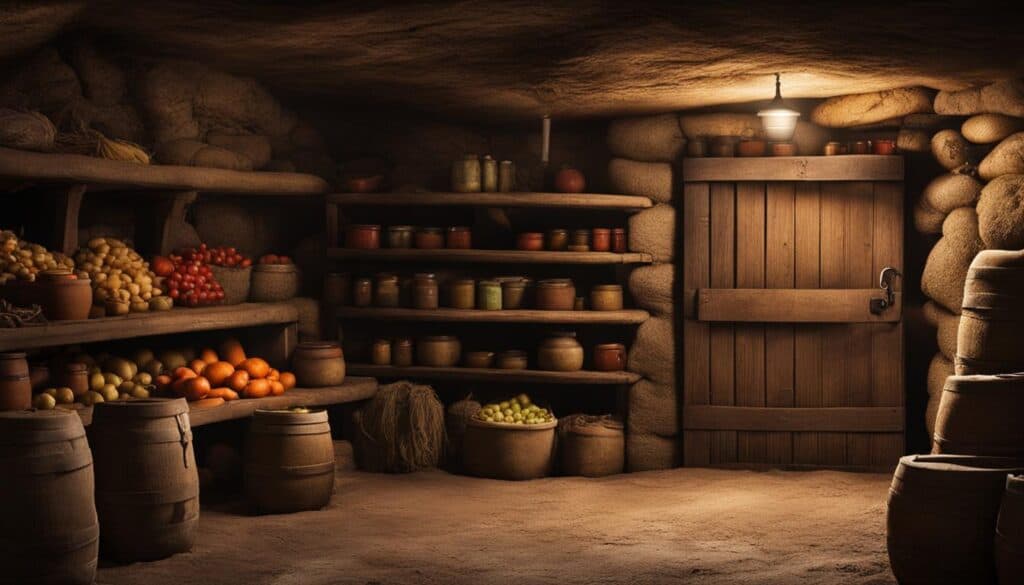
Crop Comparison
| Crop | Basement Root Cellar | Hole-in-the-Ground Cellar | Garbage Can Root Cellar |
|---|---|---|---|
| Carrots | ✔️ | ✔️ | ✔️ |
| Potatoes | ✔️ | ✔️ | ✔️ |
| Onions | ✔️ | ✔️ | ✔️ |
| Apples | ✔️ | ❌ | ❌ |
| Squash | ✔️ | ❌ | ❌ |
| Beets | ✔️ | ✔️ | ✔️ |
How to Keep Your Root Cellar Cool
Achieving the optimal temperature in a root cellar is crucial for preserving your produce. Here are some tips to help you keep your root cellar cool and maintain temperature stability:
Digging Deeper for Temperature Stability
To achieve complete temperature stability, consider digging your root cellar deeper. Typically, complete stability is reached at around 10 feet (3 meters) deep. By going deeper, you can create a more consistent and cool environment for your stored fruits and vegetables.
Avoiding Tree Roots
When choosing the location for your root cellar, it’s important to avoid building near large tree roots. Tree roots can affect the temperature and humidity levels in the cellar, potentially compromising the preservation of your produce. Select a spot where tree roots won’t interfere with the airflow or the stability of the root cellar.
Promoting Airflow with Wooden Shelving
Proper airflow is essential for maintaining the desired conditions in your root cellar. Use wooden shelving to help facilitate airflow, as wooden shelves allow air to circulate more easily compared to solid surfaces. Be sure to leave space between the shelves and the walls to allow air to move freely.
Considering Flooring Materials
The choice of flooring material in your root cellar can impact the temperature and humidity levels. Packed earth and concrete are popular options that provide good insulation and help maintain the desired conditions. Consider the existing soil composition and the insulation properties you want to achieve when selecting your flooring material.
Monitoring Temperature and Humidity
Regularly monitoring the temperature and humidity levels in your root cellar is vital for ensuring optimal storage conditions. Use a thermometer and hygrometer to keep track of these parameters and make any necessary adjustments to maintain the desired environment.
Ensuring Proper Ventilation
Proper ventilation is crucial for preventing the buildup of excess moisture and maintaining stable conditions in your root cellar. Ensure adequate ventilation by providing vents or openings that allow fresh air to enter and circulate within the cellar. This helps prevent excess humidity and promotes a healthier storage environment for your produce.
By following these tips, you can create a root cellar that maintains the cool and stable conditions necessary for preserving the freshness and quality of your stored fruits and vegetables.
Tips for Storing Your Harvest
When it comes to storing your bountiful harvest in a root cellar, there are several important tips to keep in mind. By following these guidelines, you can ensure the long-term preservation of your fruits and vegetables.
- Late-season harvesting: To maximize storage life, it’s best to stock your root cellar as late in the season as possible. This allows the produce to fully ripen and develop optimal flavors before being stored.
- Chilling produce: Before placing your fruits and vegetables in the root cellar, it can be beneficial to chill them in the refrigerator. This extra step helps extend their shelf life and maintain their freshness.
- Curing vegetables: Some vegetables, such as potatoes and winter squash, benefit from a curing process before storage. This involves allowing them to dry in a warm, well-ventilated area for a few days to toughen their skins and enhance their storage qualities.
- Handling with care: Proper handling is crucial to prevent bruising and decay. Be gentle when handling your harvested crops, as even minor bruises can lead to rotting.
- Placement: Consider the moisture and temperature preferences of different produce when determining their placement in the root cellar. For example, root vegetables prefer higher humidity levels and cooler temperatures, while fruits like apples and pears thrive in slightly drier conditions.
- Fruit wrapping: Wrapping certain fruits, such as apples and pears, in paper can slow down the release of ethylene gas, which promotes ripening and can lead to spoilage. The paper wrapping helps maintain the firmness and freshness of these fruits.
- Moisture control: Monitoring and controlling the moisture levels within the root cellar is crucial. Excess moisture can lead to mold and rot, while too little moisture can cause shriveling. Maintain appropriate humidity levels to ensure the longevity of your stored crops.
By implementing these tips for storing your harvest, you can extend the shelf life of your homegrown fruits and vegetables and enjoy their freshness even during the off-season.
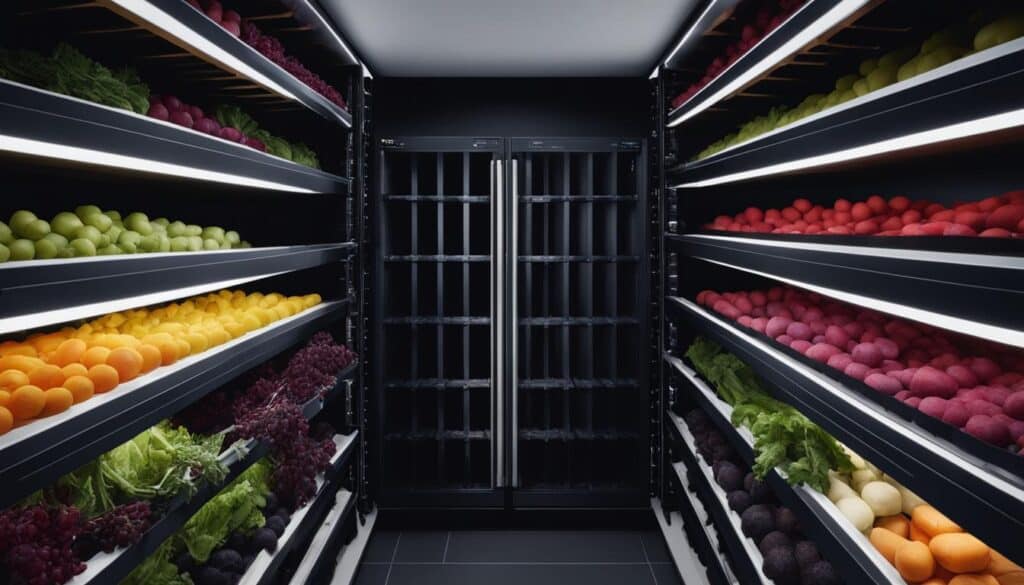
Crops for Cool and Damp Root Cellars
When it comes to storing your harvest in a cool and damp root cellar, certain crops thrive in these conditions. Here are some moisture-loving crops that are ideal for your cellar:
- Apples: Delicious and versatile, apples can be stored for months in a cool and damp root cellar. To ensure their freshness, wrap each apple in newspaper before storing.
- Pears: Similar to apples, pears can be successfully stored in a root cellar. Place them in a single layer and wrap any bruised or damaged pears in newspaper to prevent spoilage.
- Carrots: These vibrant orange roots are excellent candidates for root cellars. Before storing, remove the green tops and place the carrots in a container filled with moist sand for optimal freshness.
- Turnips: With their distinctive flavor, turnips are well-suited for cool and damp root cellars. Remove the greens and store them in a container covered with moist sand.
- Parsnips: These sweet and nutty roots are enhanced by the cool and damp environment of a root cellar. Trim the greens and store them in moist sand for maximum flavor.
- Beets: Known for their rich color and earthy taste, beets are a great choice for root cellar storage. Remove the greens and store them in a container filled with moist sand to maintain their texture and flavor.
- Rutabagas: With their distinct flavor and versatility, rutabagas are suited for cool and damp root cellars. Remove the greens and store them in moist sand to keep them fresh and delicious.
- Winter Radishes: These spicy and crisp radishes are ideal for cool and damp storage. Remove the greens and pack them in moist sand for extended shelf life.
By maintaining the cool and damp conditions required for these crops and following proper storage practices, you can enjoy the freshness and quality of these fruits and vegetables throughout the winter months.
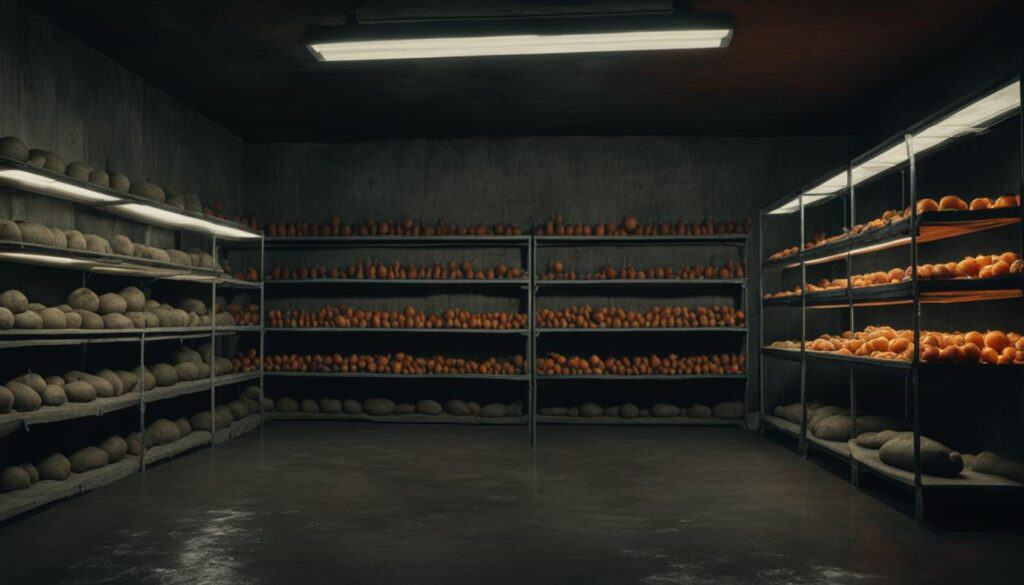
Image: A well-organized root cellar with crates of fresh fruits and vegetables.
Utilizing DIY Root Cellar Ideas
In situations where building a traditional root cellar is not possible, there are various DIY root cellar ideas that you can implement. These ideas allow you to create storage solutions for your fruits and vegetables even with limited space or resources.
Backyard Root Cellar
If you have a backyard, you can use large buckets or barrels buried in the ground to create a makeshift root cellar. Simply dig a hole deep enough to accommodate the container and place your produce inside. Cover the container with a lid or piece of plywood to protect it from the elements.
Indoor Root Cellar
Don’t have outdoor space? No problem! Look for unused closets or even crawl spaces in your home that you can convert into an indoor root cellar. Install shelves or use storage containers to keep your fruits and vegetables organized and easily accessible. Make sure to insulate the space and regulate the temperature and humidity levels for optimal storage conditions.
Earth Pit Root Cellar
An earth pit root cellar is another DIY option that can be created by digging a hole in the ground and filling it with sand or sawdust. This method provides insulation and helps maintain the desired temperature and humidity levels. Place your produce in baskets or crates and bury them in the sand or sawdust, ensuring they are well-covered and protected.
Heeling in Vegetables
Another simple yet effective DIY method is heeling in vegetables directly in the garden. This technique involves burying your harvested vegetables in shallow trenches with straw or leaves for insulation. The layer of organic material helps maintain a consistent temperature, protecting your vegetables from frost and excessive moisture.
No matter which DIY root cellar idea you choose, it’s important to monitor the storage conditions regularly. Check the temperature and humidity levels to ensure they remain within the optimal range for the longevity of your produce. With these creative solutions, you can enjoy homegrown fruits and vegetables throughout the year, even without a traditional root cellar.
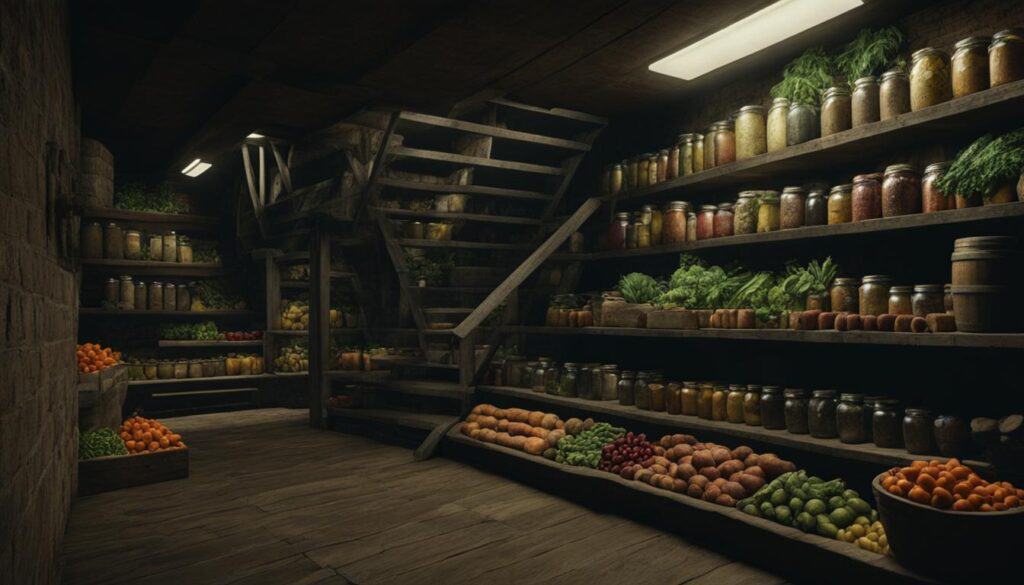
Basic Considerations for Root Cellar Design
Designing a root cellar requires careful consideration of various factors to ensure optimal storage conditions for fruits and root vegetables. By addressing key elements such as temperature control, ventilation, location, humidity, darkness, accessibility, and storage containers, you can create an effective and efficient root cellar.
Temperature Control
Maintaining the right temperature is crucial for preserving the freshness and quality of stored produce. The ideal temperature range for a root cellar is 32º to 40ºF (0° to 4.5°C), providing the cool environment necessary to prevent spoilage and extend the shelf life of fruits and vegetables.
Ventilation
Proper ventilation is essential to regulate airflow within the root cellar. This helps maintain a consistent temperature and prevents the buildup of excess moisture that can lead to mold and rot. Adequate ventilation can be achieved through vents, screened openings, or strategically placed air ducts.
Sheltered Location
When choosing a location for your root cellar, it’s important to consider protection from external elements. Opt for a sheltered area that is insulated from extreme weather conditions and direct sunlight. This will help maintain a more stable internal temperature and reduce the risk of temperature fluctuations.
Humidity Control
Managing humidity levels is crucial for preventing produce from drying out or becoming too moist. Ideally, a root cellar should have a humidity range of 85 to 95 percent. To maintain optimal humidity, you can incorporate techniques such as using humidifying trays, placing damp sand or water-filled containers, or using a dehumidifier if necessary.
Darkness
Keeping the root cellar dark is vital for preserving the quality of stored produce. Exposure to light can cause certain fruits and vegetables to spoil quickly or lose their nutritional value. Ensure that your root cellar provides complete darkness by using blackout curtains, covering windows, or positioning the cellar away from light sources.
Accessibility
Easy accessibility is essential for effectively managing and organizing your stored produce. Design your root cellar in a way that allows convenient access to different storage areas and shelves. Ensure sufficient space for walking, maneuvering, and reaching items without causing damage to the stored produce or containers.
Storage Containers
Choosing the right containers for storing fruits and root vegetables is crucial for maintaining their freshness and preventing spoilage. Opt for untreated wooden shelves and boxes that allow for proper airflow and moisture control. Avoid using plastic containers that could trap moisture and lead to rot.
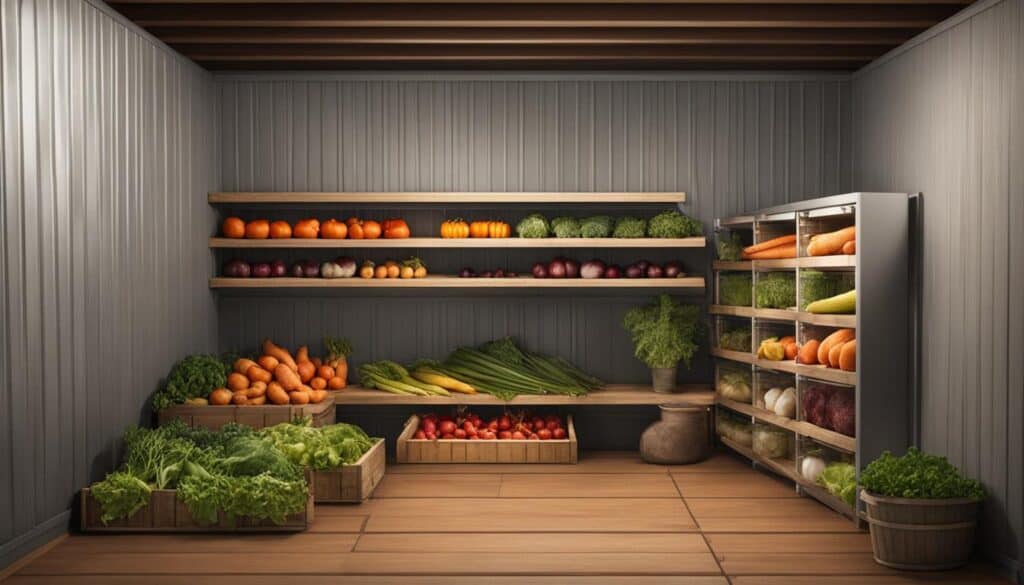
By paying attention to these basic considerations, you can create a well-designed root cellar that provides the optimal storage conditions needed to preserve the quality and shelf life of your fruits and root vegetables.
Conclusion
Root cellars offer numerous benefits for optimal storage and preservation of produce. With their cost-effective and sustainable approach, they provide a reliable method for storing fruits and root vegetables, reducing reliance on refrigeration and grocery stores. By following the guidelines for root cellar design and employing proper storage techniques, gardeners can enjoy the freshness and taste of homegrown produce throughout the year.
One of the key advantages of root cellars is their ability to maintain the quality of vegetables, ensuring long-lasting freshness. By creating the ideal temperature and humidity conditions, root cellars create an environment that slows down the natural decay process, allowing produce to stay in prime condition for extended periods. This helps reduce food waste and ensures a steady supply of nutritious and delicious homegrown produce.
Additionally, root cellars contribute to food security by providing a reliable storage solution that is independent of external factors such as supply chain disruptions or power outages. When properly maintained, root cellars can keep produce fresh and accessible even during adverse conditions. This makes them an invaluable resource for individuals and communities seeking self-sufficiency and resilience.
In conclusion, root cellars are a practical and efficient way to preserve and store fruits and root vegetables. They offer benefits such as optimal storage conditions, reduced reliance on refrigeration, and increased food security. By leveraging the advantages of root cellars and implementing proper storage techniques, individuals can enjoy the convenience, cost savings, and fresh taste of homegrown produce throughout the year.
FAQ
What is a root cellar?
A root cellar is a storage location that utilizes the natural cooling, insulating, and humidifying properties of the earth to store root vegetables, fruits, canned or pickled vegetables, and homemade alcoholic beverages.
What are the advantages of root cellars?
Root cellars offer several advantages, including the ability to store high-quality homegrown vegetables, food security, independence from supply chain interruptions, and lower electric bills.
What are the requirements for a root cellar?
To create an effective root cellar, it is important to maintain a temperature of 32º to 40ºF (0° to 4.5°C) and a humidity level of 85 to 95 percent. Root cellars may not be suitable for warm Southern climates, and it is important to comply with local building regulations and consider the proximity of the water table and ease of access.
What are the types of root cellars?
There are several types of root cellars, including basement root cellars that utilize existing foundation walls, hole-in-the-ground cellars that involve digging into the ground or a hillside, and garbage can root cellars where a metal garbage can is buried in the ground and filled with crops.
How can I keep my root cellar cool?
Achieving the optimal temperature in a root cellar often requires digging deeper, avoiding building near large tree roots, ensuring proper airflow with wooden shelving, choosing the right flooring material, and monitoring the temperature and humidity with a thermometer and hygrometer.
What are some tips for storing my harvest in a root cellar?
When preparing to store your harvest in a root cellar, it is beneficial to stock the cellar as late in the season as possible, chill the produce in the fridge beforehand, cure certain vegetables like potatoes and winter squash, handle the produce gently to avoid bruising, and consider the placement of different produce based on moisture and temperature preferences.
What crops are suitable for cool and damp root cellars?
Cool and damp root cellars are suitable for storing moisture-loving crops such as apples, pears, carrots, turnips, parsnips, beets, rutabagas, and winter radishes. Storing apples and pears wrapped in newspaper and root crops in moist sand can help maintain freshness and quality.
Are there any DIY root cellar ideas I can try?
Yes, in situations where building a traditional root cellar is not possible, you can try DIY root cellar ideas such as using large buckets or barrels buried in the ground, converting unused closets into root cellars, creating earth pit root cellars by digging a hole and filling it with sand or sawdust, or heeling in vegetables directly in the garden with straw for insulation.
What are some basic considerations for root cellar design?
When designing a root cellar, consider factors such as temperature control, ventilation, finding a sheltered location, maintaining optimal humidity levels, ensuring darkness, providing easy accessibility, and using appropriate storage containers like untreated wooden shelves and boxes.
What benefits do root cellars offer for storing and preserving produce?
Root cellars provide a cost-effective and sustainable method of storing fruits and root vegetables, reduce reliance on refrigeration and grocery stores, and allow for the freshness and taste of homegrown produce throughout the year.

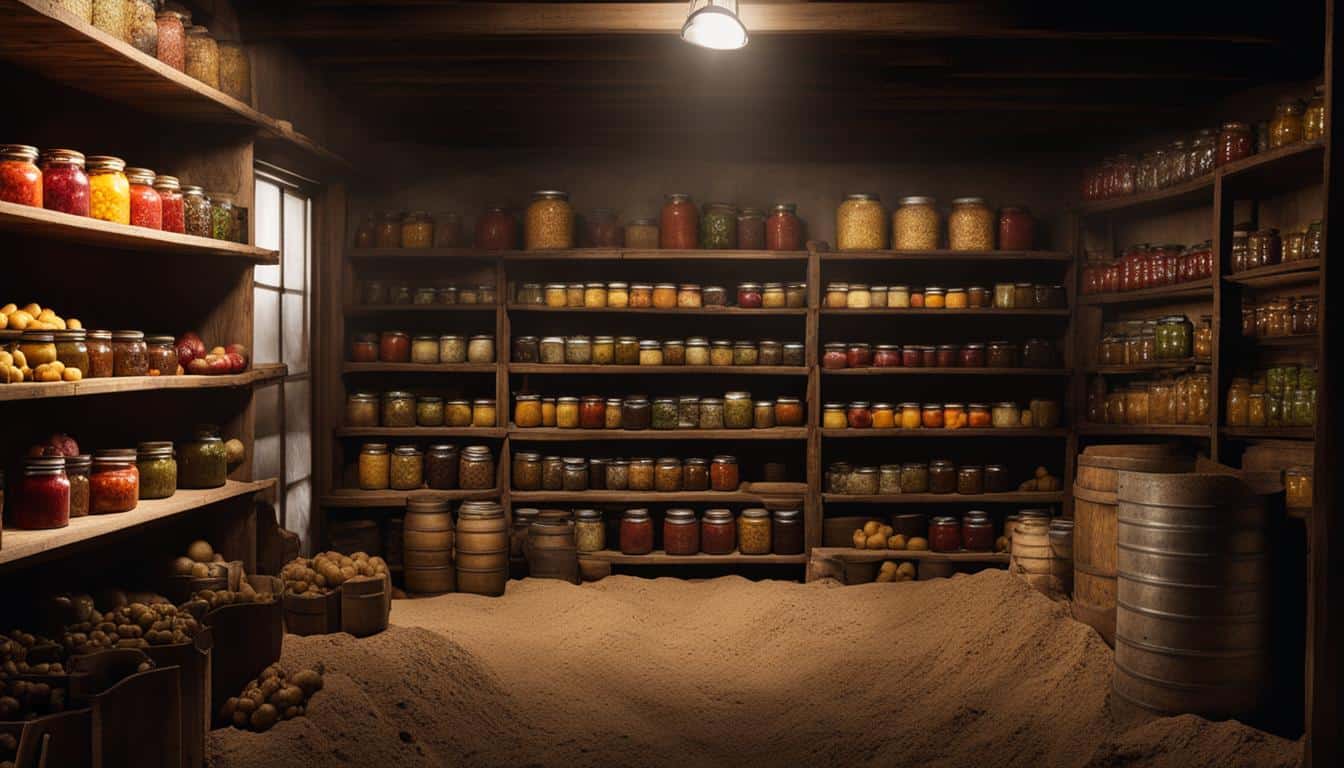



Leave a Reply